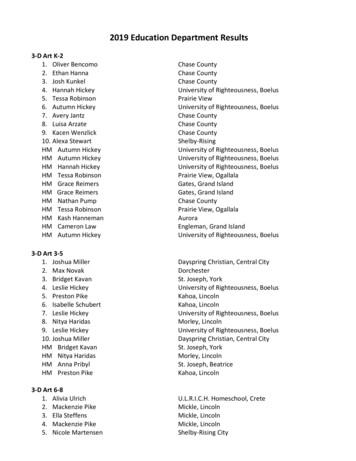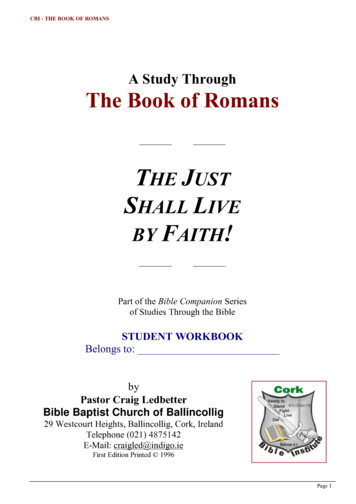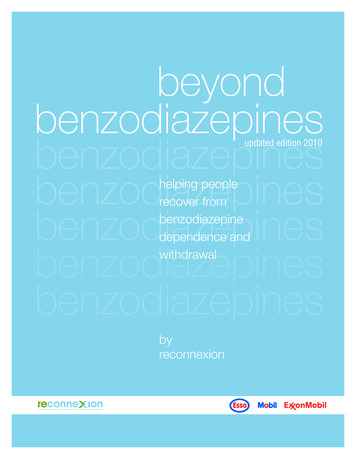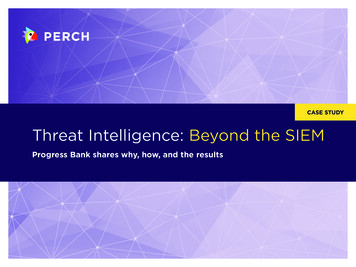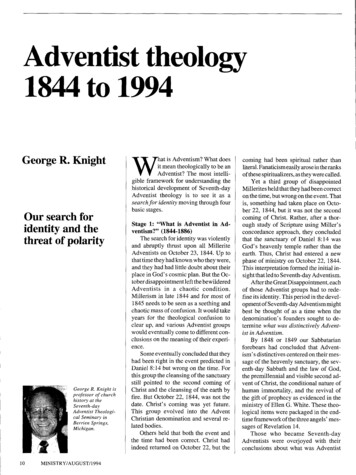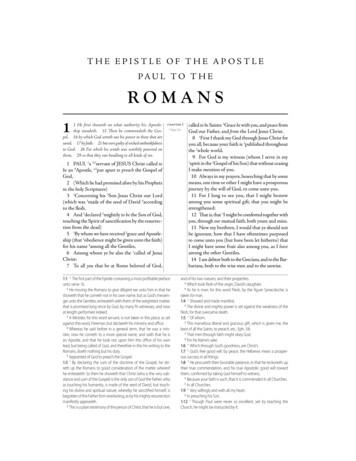
Transcription
Beyond righteousness and transgressionIntroductionIn 2006 National Geographic Society published a Coptic text on their website: The Gospel of Judas, inwhat follows the GospJud. That a document in which a disciple called Judas seemed to play a centralrole circulated on the black market had been known since 1982.1 The codex of which the text is apart suffered immensely by the treatment of people who were not up to the task of handling anancient document. In 2000 the church historian and coptologist Bentley Layton discovered that theJudas of the codex was Judas Iscariot. Finally, when the text was published the group of scholars whohad done a fantastic work reconstructing the seriously damaged text published books in which theyclaimed that this Christian Gnostic gospel revealed a conversation between Judas and Jesus in whichit was evident that they had concluded a pact. According to the initial line of interpretation, Judas’task was to help Jesus to be released from his fleshly prison in which his spirit was captivated.Moreover, Judas was the favorite disciple, the only one who understood the message of Jesus.2 Fromthe beginning the view of sacrifice in the GospJud was related to an evaluation of Judas Iscariot whoparticipated in the sacrificing of Jesus. Soon however, other scholars, including myself, challengedthis interpretation. Judas knew Jesus, not because he was the most insightful and good disciple, butbecause he was a demon. Sacrificing Jesus was of no significance. Rather it was carried through bypeople who confused Jesus’ spiritual essence with his docetic appearance.3 This short summaryshows that minefields of very theologically marked discourses are involved when we analyse theGospJud. In order to take up stand on the view on sacrifice in the GospJud we have to make somepreparatory work. First, I have to deal with some myth-theoretical considerations. Second, I willintroduce a new perspective on the manner in which so-called Gnostic myths could be used. Ourexample will be the Gospel of Truth from Nag Hammadi, (in what follows GospTruth. Then, we areable to analyse the GospJud from a new perspective and thereby to draw a conclusion as for what wecan say on the view on sacrifice that is represented in that text.The quandary of deconstructionAs this article is part of a cross-disciplinary conference volume it is appropriate to relate a debate onGnosticism that has been going on among specialists the last fifty years and in particular the last twodecades. Before the discovery of the Nag Hammadi texts in 1945 scholars more or less had to buildtheir understanding of Gnosticism on the polemical reports. The reading of the now available primarytexts made it obvious that many of the clichés hitherto connected to Gnosticism were problematic. In1966, leading scholars gathered in order to formulate definitions that would be up to date with thenew available sources. In their final statement a distinction between Gnosticism and gnosis wasmade:1Krosney, 2006 and Magnusson 2008 for more information about the discovery.For early interpretations see Kasser, Meyer & Wurst, 2006 and Pagels & King, 2007.3For a critique of the earliest view see for instance, De Conick, 2007, Robinson, 2007, Magnusson, 2008,Painchaud, 2008 & Thomassen, 2008. Recently Jenott, 2011 has critiized the opinion that the GospJudrepresents a negative view on sacrifice and of Judas Iscariot.2
In order to avoid an undifferentiated use of the terms gnosis and Gnosticism, it seems to be advisable toidentify, by the combined use of the historical and the typological methods, a concrete fact, "Gnosticism",beginning methodologically with a certain group of systems of the Second Century A.D. which everyone agreesare to be designated with this term. In distinction from this, gnosis is regarded as "knowledge of the divine4mysteries reserved for an elite".Then the scholars went about trying to distinguish common characteristics among the SecondCentury sects.As a working hypothesis the following formulations are proposed:I. The Gnosticism of the Second Century sects involves a coherent series of characteristics that can besummarized in the idea of a divine spark in man, deriving from the divine realm, fallen into this world of fate,birth and death, and needing to be awakened by the divine counterpart of the self in order to be finallyreintegrated. Compared with other conceptions of a "devolution" of the divine, this idea is based ontologicallyon the conception of a downward movement of the divine whose periphery (often called Sophia or Ennoia) hadto submit to the fate of entering into a crisis and producing—even if only indirectly—this world, upon which itcannot turn its back, since it is necessary for it to recover the pneuma—a dualistic conception on a monisticbackground, expressed in a double movement of devolution and reintegration.II. The type of gnosis involved in Gnosticism is conditioned by the ontological, theological and anthropologicalfoundations indicated above. Not every gnosis is Gnosticism, but only that which involves in this perspective theidea of the divine consubstantiality of the spark that is in need of being awakened and reintegrated. This gnosisof Gnosticism involves the divine identity of the knower (the Gnostic), the known (the divine substance of one'stranscendent self), and the means by which one knows ( gnosis as an implicit divine faculty is to be awakenedand actualized. This gnosis is a revelation-tradition of a different type from the Biblical and Islamic revelation5tradition).Even though the conference report made it clear that Gnosticism had a close relation toMandaeanism and Manichaeism scholars of Gnosticism with a few exceptions have excluded thesetraditions. I would say that the definition of 1966 not only was a reaction to the increased availablematerial but at least as much to the brave conclusions that old comparativists drew from sometimesill-defined parallels. However, scholars of today that deals with “the Second Century sects” have notfelt at ease by using the Messina definition from 1966. Their critique, however, to a large extent hasbeen against clichés related to Gnosticism that were not included in the definition. Frequently theseclichés are based on a simplified view on the relation between the myth that people believe in andthe social behavior that would be the outcome of the belief. For instance, scholars of earliergenerations often held that Gnostics, due to the anticosmisity of their myths, would revolt againstthe cosmic order of the creator god by ignoring ethical norms or revolting against social45Bianchi 1967 XXVI.Bianchi, 1967 XXVI- XXVII.
conventions.6 Moreover, Gnostics were held to interpret Biblical material in a manner that wouldreverse the reading of so-called “orthodox” Christians. Another example is the notion that Gnosticswould be uninterested in ethics. They saw themselves as beings that due to their spiritual nature didnot have to bother themselves with ethics; they would be saved in any case. Ethics was for thosewho could go astray and thus perish. For the Gnostic the choice stood between libertinism andascetism.7 If Gnostics happened to be interested in ethics, it was seen as inconsistent with the viewsthat they were expected to hold.8 Today, however, I would say that specialists have stoppedrepeating such stereotypes. On the contrary, if anyone infers a link between the Gnostic myths andthe moral conduct of the Gnostics, the conclusion rather is that Gnostics maintained at least as highethical standards as other Ancient Christians or Pagans. Sometimes it has been claimed that theirbelief in their supposed divine spiritual spark rather encouraged them to understand more and to actmore ethically than others.9 But the main tendency has been to cut the connection between Gnosticmyths and ethical conduct. Most of the critique of using the term Gnosticism primarily seems to bedirected against the clichés that actually were not included in the definition. Michael A. Williams hasbeen very successful in demonstrating the weaknesses in for instance the above mentionedstereotypes. Nevertheless he seems to be pessimistic about the probability of getting rid of theclichés as long as the label Gnosticism is used. For this reason he has coined the term “BiblicalDemiurgical traditions” that has a lot in common with the typological characteristics mentioned inthe Messina definition. He maintains that such a clearly modern constructed definition would avoidthe deeply rooted clichés that many expect to accompany Gnostic texts. Consequently, Williamsattempt is to build a category out of typologies deduced from the myths in Biblical Demiurgicaltraditions. Moreover, he wants to use a category that would not be linked to notions that there wasa group that called themselves Gnostics.10 Layton11 and Brakke12 goes the opposite way and want tostart from the group that might have called themselves “the Knowers”. Then they describe the mythsthat the polemical writers were used by the Knowers. As these myths seems very similar to what onefinds in for instance the Apocryphon of John they end up with something very similar to whatscholars long have called “classical Gnosticism”. Especially for Brakke it is important to stress that theGnostics were Christians and he sides with Williams as for the critique of the stereotypes that toooften were related to the Gnostics. Birger Pearson has been severely criticized by many scholars forclaiming that Gnosticism was a religion of its own, not denying that there were Christian Gnostics aswell. He starts out as Brakke with the group that designated themselves as “the Knowers”. From thisPearson builds up what he calls classical Gnosticism that he asserts had its origins in Judaism. He thengoes on to include for instance Mandaeans and Manichaeans because of structural similarities withthe classical Gnostic myth. Influenced by Williams Pearson stresses that the stereotyped view onGnosticism belongs to a past state.136Jonas, 1963 46. Even pagan moral philosophy should have been discarded by the Gnostics, Jonas, 1963 160.Jonas, 1963 270-276 who saw libertinism as the core of Gnosticism, whereas Rudolph 1983, 253-255 ratherstressed the ascetic side.8Desjardins, 1990 2-3.9Pagels, 1989 70-73, Mahe, 1998 35.10Williams, 1996 51-53.11Layton, 1995.12Brakke, 2010.13Pearson, 2007 140, 164-65.7
Karen King is often related to Williams but has a distinctly different approach. She describes thestrategies that the polemic writers adopted when they wanted to construct two groups. Their ownchurch descending from Jesus and the apostles, versus the other of heretics. According to King,Gnostics were attached to all kinds of heresies and accused for all sorts of evil things.14 Then shecontinues to show that they should not be attached to the stereotypes that often have beenconnected to them. So far so good, Williams and King have a lot in common. But when King thentakes examples of so-called Gnostic texts and shows that they cannot be called Gnostics becausethey lack the clichés that according to herself should not be linked to Gnostics I have difficultiesfollowing the logic. Below I quote her assessment of the Gospel of Truth that we will deal with atlength later in this article.GospTruth, a writing from the mid-second century thought by many scholars to have been written by "the archheretic" Valentinus himself, is an excellent example of a work that defies classification as a "Gnostic" text. Thisremarkable work exhibits none of the typological traits of Gnosticism. That is, it draws no distinction betweenthe true God and the creator, for the Father of Truth is the source of all that exists. It avows only one ultimateprinciple of existence, the Father of Truth, who encompasses everything that exists. The Christology is notdocetic; Jesus appears as a historical figure who taught, suffered, and died. Nor do we find either a strictly15ascetic or a strictly libertine ethic; rather, the text reveals a pragmatic morality of compassion and justice:Taking for granted that King is right in her assessment of the GospTruth she has not proved anything.The only thing we might conclude is that the GospTruth might be a Gnostic text without the clichésthat King wants to do away with. We will return to some of the issues as for the GospTruth later inthis article. In 2006 she goes further and claims that the only label that would be appropriate to useis Christian.16 Categorizations as Christian Gnostics, Valentinians etc would only marginalize thesegroups in relation to the disparate body of churches that in the second century were about to bedeveloped into pre-orthodox Christianities. Thus, on the one hand King is scrupulous about avoidingforcing texts in categories that would conceal the meaning of the individual text. On the other handthis deconstructionist approach leads to reading text in macro categories. The drawback is thatChristian is a category that badly needs to be divided into subdivisions if it would be of analyticalvalue. Dunderberg follows King and uses the term Christian, although he still finds Valentiniansappropriate for the group he investigates. Recently Jenott has claimed that the Gospel of Judas, theother text that we will focus upon, has been misinterpreted because scholars have read it as aGnostic text. Referring to Williams and King he calls it Christian.17Conclusion and point of departureWe set out with the definition of Gnosticism from 1966. There, the scholars dissociated themselvesfrom a more comparative position. Mandaeism and Manichaeism were excluded from Gnosticism, aswell as other trends within Hinduism, Buddhism and for instance Pythagorean traditions. Instead the14King, 2003 20-54.King, 2003 192.16King, 2006 IX -X.17Jenott, 2011 1.15
Second Century Christian sects were the starting point for the historical and typological definition. Itis noteworthy that these groups that would form the beginning of a phenomenon also seem to havebecome the end of it. Rarely scholars detect a continuation of the Ancient Gnostic traditions in laterperiods. This might be caused by the difficulty to find something that would fit the Messina definitionin later sources. Those scholars who go further on in history include Manichaeism and Mandaeism intheir investigations. Hermetism that earlier was included in the study of Gnosticism and that has alonger history nowadays is excluded. Without having dug deep into the discussions that preceded theconference in 1966, I suggest that a general tendency to distance oneself from earlier trends in thecomparative study of religion was of importance for the conference report. When Gnosticism isdefined narrowly the discussion naturally focuses on the relation between Gnosticism and othersubdivisions of Christianity. The Nag Hammadi texts and the Tchacos codex show nothing of thestereotypes earlier connected to Gnosticism. Although many scholars continue to define Gnosticism,or in William’s case Biblical Demiurgical traditions, on basis of the myths one have stopped askingwhat function the myths might have had for those who saw them as sacred narratives. Maybe this isdue to the risk of being accused of associating oneself with those who constructed the stereotypesand who later upheld them. Thus, the clear-sightedness brought by scholars as Williams is veryvaluable. But it has to be combined with myth-theoretical investigations as for the function of myth.Otherwise the clear-sightedness that has been achieved the last decades risks to be replaced with atheoretically too undifferentiated view. In this article I will put forward a proposal for the use ofmyth in the Gospel of Truth and then see if this new perspective could help us analyzing the view onethics and sacrifice in the Gospel of Judas. By doing this I want to form a hypothesis that could betested on other material as well. We might be able to use it across religious borders and in this wayre-establish the comparative study in this field. It goes without saying that this is my first step on ajourney that even if it would show promising results would have to be tested in many investigations.On the theoretical level I am influenced by fairly general insights from the new comparativism in thehistory of religions.18 Typological investigations too often have been carried through without takinginto account of how the different types were used in the respective texts. This was one of thedrawbacks in old comparativism. I also want to challenge the deconstructive tendency that for surehas taught us to be more careful but also have undermined the will of explaining relations betweendifferent phenomena. As for the discussion above, we have deconstructed categories down to thelevel of individual texts, but ended up with an even more fluid category that is hard to use inanalytical work: Christianity. Stating that we deal with nothing else than Christianity rather seems tobe a theological statement than a methodological one. Presently I see no reason to invent anotherterm for Gnosticism. The awareness of the problems in earlier investigations has grown rapidlyamong specialists and in time it will spread to non-specialists. Besides, many still use Gnosticismoutside of the restricted sense from 1966. Scholars of Mandaeism, Hinduism, and Buddhism and ofNew Religious Movements have less negative views on what Gnosticism could have been.Before starting, some words on myth might be appropriate. Many definitions of myth could do forthe present purpose, but I have chosen Wendy Doniger’s:18Paden, 2008 provides a good summary of the state of affairs.
a myth is: a narrative in which a group finds, over an extended period of time, a shared meaning in certainquestions about human life, to which the various proposed answers are usually unsatisfactory in one way oranother. These would be questions such as, Why are we here? What happens to us when we die? Is there a19God?What I especially want to stress here is Doniger’s remark that a myth is a story and not an idea. Onecould, according to Doniger, start out with a metamyth that ideally would consist of subjects andpredicates only. Every time when a myth is told the teller adds something to it. Those additions cantell us something about the context and use of the myth in that specific context. Theoretically wecould think of a maximyth that would consist of all those additions to the minimyth, but of course,none of these metamyths have existed. An example of her reasoning is quoted below:For example, the hypothesis of an unmarked, neutral experience involving a woman, a man, a garden, a tree, afruit, a snake, and knowledge allows us to understand how the Hebrew Bible could tell that story as it does (anevil snake, forbidden fruit, evil woman, disobedient and destructive knowledge), while other interpretations ofthat story tell it differently . The positive reading of the serpent (though not of the woman) was, however,accepted in the Ophite version of Genesis, in which Yaldabaoth (God) is evil, and the serpent is good. It wasfurther developed by Romantics such as Shelley, who saw a direct parallel between Satan's gift of the fruit andPrometheus' gift of fire—a gift that, like the fruit in Eden, provoked the wrath of the jealous gods and the20creation of the first, disastrously seductive woman, Pandora.According to this reasoning, a myth would not lead to a specific ethical attitude or behavior; on thecontrary, the myth could be interpreted in many ways. However, one could not say that anythinggoes. The interpretation must be meaningful for the interpreter so the context of the interpreter andthe ways in which the myth use to be interpreted will delimit the range of additions to andinterpretations of the myth. Therefore, we cannot use the simplified view on myth as earlier scholarsoften did, nor should we overlook the importance of the myth that it seems as modern scholars havetended to do. First, I would say that the myth can be interpreted in many ways, but not in an infinitenumber. The story has to be intelligible. This level is mostly semantic and syntactic. Second, thevariations depend on the rules that determine the discourse. By this I mean the manner in which themyth used to be interpreted in the historical environment. The discourse will normally follow somefor the specific context conventional rules. Of course, I am influenced by Foucault in this part of mypositioning, but for the present purpose we do not need to go deep into his theories. This secondlevel can be distinguished but probably not isolated from the first level, since semantics andsyntactics also is a part of a discursive practice. Third, the myth is colored by a narrower context thanthat mentioned in my second statement. And here the particularities of the negotiation of powerbetween the teller of the specific version of the myth and the community that decided to preserve itmight help us see in what way they used it. It is on this third level that I assert that many analyses ofmyths have failed. Too often parts of a myth are taken out of the narration and thus changed intodogmatic statements. In the following analysis I will try to avoid this by paying more attention to the1920Doniger 1996 112.Doniger 1996 120.
text-surface than normally has been the case. Here I am influenced by text linguistic theories. Often Icould say that I use what earlier was called rhetorical analysis in my aim at disclosing the strategiesthat the authors of the Gospel of Truth and the Gospel of Judas used in order to persuade theiraudiences.Beyond anticosmisityThe GospTruth), is one of the most studied texts from the Nag Hammadi discovery. It is wellpreserved in the First codex. In codex twelve we have a few fragments of what I see as a later versionof the text. In this article, however, I will concentrate on parts of the GospTruth that are notpreserved in the fragments. Thus GospTruth always refers to codex I. As for the authorship of theGospTruth. Many scholars among whom I am included suggest that it stems from Valentinus ofAlexandria21 who led a community in Rome from 138. For us this is of importance as Irenaeus ofLyons reports that Valentinus was building on the Gnostic system when he developed his teaching.22In the following analyses I will argue for an interpretation of The GospTruth in which a specialinterpretation of the Gnostic myth is criticized and modified. Now it is time to turn to the textanalysis. The GospTruth starts as follows.The good news of the truth is a joy for those who have received the grace from the Father of the truth, thatthey might know him through the power of the Word that came forth from that Fullness that is in the Father'sthought and mind, this is what they call “the Redeemer” since that is the name of the work that he was toaccomplish for the redemption of those who were ignorant of the Father, and since the name of the good news23is the revelation of the hope, since it is the discovery for those who are searching for him.As the vast majority of scholars I assume that the GospTruth is a homily. When the speaker stepsforward in order to preach, from a text linguistic point of view this corresponds to a marker on thepragmatic level, i.e. the community knows that a homily will follow. But the attitude on the part ofthe community to the preacher is less obvious. Harold W. Attridge has suggested that the GospTruthis an exoteric text in which the audience rather consisted of non-Gnostic Christians who graduallywere persuaded to adopt a reinterpreted version of the gospel.24 This was an important attempt toanalyse the rhetorical context of the GospTruth, and maybe even more importantly, to see in whatway the audience is persuaded to change their view. For reasons that will be discussed throughoutthe following pages I assume that the audience consisted of people who were acquainted with some212223For a detailed discussion of authorship, date of composition etc see Magnusson, 2006 13-44.Irenaeus, Against the Heresies 1.11.1.All quotations from the GospTruth are from Nag Hammadi Codex I. In this case from 16.31-17.4a. Unlessotherwise is indicated, all translations are my own.24“”The presupposed theology is concealed so that the author may make an appeal to ordinary Christians,inviting them to share the basic insights of Valentinianism.”” Attridge 1986 139-140.
sort of Gnostic myth that gradually became reinterpreted.25 Granting this, those who call the Wordtheir redeemer is the community. Although ignorance of the Father had made itself painfully felt,now the community is said to be in a state of joy as they know the Father. This initial sentence, Isuggest, does not function as a prologue to the following main part of the homily26 as all otherscholars have treated it as. This observation is more than a quibbling with delimitation in a linguisticover-technical jargon. Rather, it means that the following sentence that opens with a causalconjunction “because” is subordinated to the first sentence. Following this logic we expectsomething that was vaguely emphasised in the first sentence to be developed and explained in thesecond. Moreover, the joy that one should experience is an instruction to the community. Despitethe scaring figure of Error that will evolve, one ought to stick to the antidote of fear: the joy thatcomes with the knowledge of the Father.27282930Because the All wandered about searching for the one from whom they had come forth, and yet the Allwas inside of him, the incomprehensible, inconceivable one who is superior to every thought,31thus ignorance of the Father brought anguish and terror, and the anguish grew dense like a fog, so that no32333435one could see, for this reason, Error found strength, worked on its own matter in emptiness since it had36not known the truth.25My general critique of Attridge's argumentation is that it does not carefully enough follow the argumentationof the text. Rather he picks up topics that seem “”familiar”” and in an interesting manner discusses in what waythey become transformed. Such an undertaking must be combined with an analysis of the text-surface and therhetorical strategies that one might disclose. For earlier studies suggesting a more esoteric setting see SäveSöderbergh 1958 and Segelberg 1959.26Even though Grobel 1960 called the GospTruth a “meditation” the overwhelming majority of scholars haveseen it as a homily. Then, the term ⲈⲨⲀⲄⲄⲈⲖⲒⲞⲚ preferably should be taken as a proclamation of the goodnews, rather than as a definition of genre.27ⲈⲠⲒⲆⲎ. Generally this conjunction is causal rather than temporal in the Nag Hammadi material. Theanaphoric and cataphoric uses of it seem to be quite evenly distributed.28ⲡⲧⲏⲣϤ29ⲕⲱⲧⲉ ⲛⲥⲁ means search for but it also has a connotation of wandering about, encircling etc. As the Father isdescribed as the one who encircles or contains everything whereas nothing contains him ⲠⲈⲦⲔⲦⲀⲈⲒⲦⲀⲘⲀⲈⲒⲦ ⲚⲒⲘ ⲈⲘⲚ ⲠⲈⲦⲔⲦⲀⲈⲒⲦ ⲀⲢⲀϤ 22 :25-27 when the stative of ⲕⲱⲧⲉ is used has influenced mytranslation. The absurdity in trying to contain the one who contains everything seems to be a background for17:4a-18a as well.30”and yet ” The Coptic conjugation perfect 1 is the main mode of narration in the past tense. Here, however,the straightforward telling of events is interrupted by the conjunction ⲁⲩⲱ followed by the preterit conversion.I assume that it expresses background information, which is the normal use of the preterit, and together withthe conjunction, which I treat as emphatic, we reach an expression of surprise. Hence the paradox that the Allcould come forth from and search for someone that they simultaneously was inside of and who is superior toeverything is underlined. This interpretation is a new attempt to reproduce the subtleties of the Copticcarefully construed syntax.31The circumstantial has caused scholars many difficulties. My rendering of it is different than that from 2006. Isee it as subordinated to the ⲉⲡⲓⲇⲏ ”because” in the beginning of the sentence.32ⲔⲀⲀⲤⲈ ϪⲈ ⲚⲈϢⲖⲀⲨⲈ ⲚⲈⲨ is an incorrect construal. Although nobody seems to have commented upon iteveryone have interpreted it as ϪⲈ ⲔⲀⲀⲤ ⲈⲚⲚⲈϢⲖⲀⲨⲉ.33ⲧⲡⲗⲁⲛⲏ has the connotation of going astray, wandering about.34”Matter”. The Coptic term is ⲏⲩⲗⲏ.35”Foolishly”. The Coptic phrase ⲏⲛⲛ ⲟⲩⲡⲉⲧϣⲟⲉⲓⲧ equally well could be translated as “”in emptiness” or“vainly”. Foolishly, I would say, makes much sense in such a context where it is opposed to truth. However, “”in
Probably, the state of searching for the Father had a familiar ring to the community. Once everybodyhad been searching for what they now had found. The remark that the All was inside of the Fatheralthough they had come forth from him expresses a paradoxical state. The Father containseverything whereas nothing contains him.37 To have come forth from the Father is true as far as theAll are his members (18:40), but it is false if one perceives it as a state of real separation from him.The bewildered state seems to be caused by the incomprehensive nature of the Father. Out of thisconfusion anguish and terror emerge. Finally, the perplexity has developed to such degree that noone can see the Father, and because of this Error finds strength. Although its power is based uponignorance, Error takes on some kind of real existence. It becomes powerful and works on its ownmatter. Finally, however, the frightening figure is diminished by the statement that its acts are of noimportance since it lacks what the members of the community have: the Truth. The sentence from17:4a-18a is skilfully designed. It opens with a causal conjunction “because”, but we have to waituntil it is caught by a result construction “therefore Error found strength”. The rhetorical function isthat when Error finally is introduced it takes up the climactic place of the period. As it also takes onmythological characteristics we have two tendencies in
Judas of the codex was Judas Iscariot. Finally, when the text was published the group of scholars who had done a fantastic work reconstructing the seriously damaged text published books in which they claimed that this Christian Gnostic gospel revealed a conversation between Judas and Jesu
